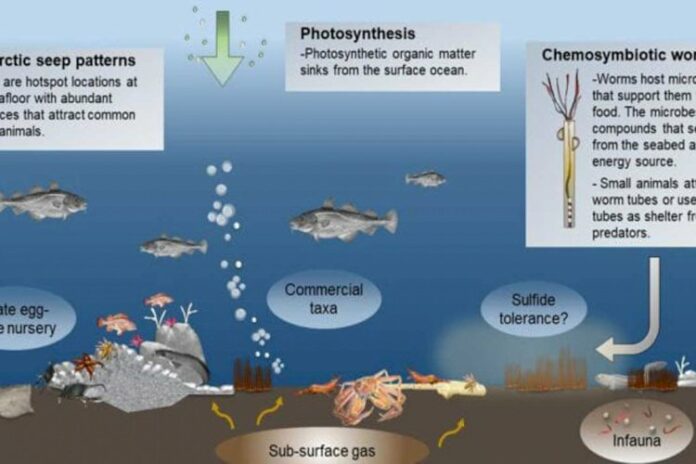Beneath the Arctic seafloor are large sources of discovered and undiscovered petroleum hydrocarbons, including methane and gas hydrate reservoirs.
Fluids and gas escaping from these reservoirs can migrate toward the seafloor and be released into the ocean. Evidence of hydrocarbon seepage is widespread in the Barents Sea and other regions of the Arctic, and what is only now being more fully appreciated is the extent to which leakages from these reservoirs are a source of energy for many components of the marine ecosystem at high latitudes.
Akvaplan-niva scientists Prof. JoLynn Carroll and Dr. Michael Carroll led an interdisciplinary research team at the Centre for Arctic Gas Hydrate, Environment, and Climate, a Research Council of Norway (RCN) Centre of Excellence based at the Department of Geosciences, UiT – The Arctic University of Norway. Working together with early career scientists, Dr. Emmelie Åström and Dr. Arunima Sen, they have just published a synthesis of research findings on benthic communities associated with sites of methane gas seepage in the Arctic. Their work sheds new light on a previously underappreciated energy resource for life in the Arctic in the context of the unique marine habitats and ecosystems they support.
Some sites of gas seepage on the seafloor, also known as cold seeps, are oases of biological activity. At these locations, methane and sulphide play an essential role for biological production via specialized microbes in a process known as chemosynthesis. This production occurs locally at the seabed and is available year-round, in contrast to the episodic supply of photosynthetic organic matter sinking from the surface ocean. In addition, reef-like structures formed by the precipitation of carbonates during seafloor methane seepage provide extensive habitat complexity.
Dr. Emmelie Åström informed:
“One of the reasons, cold seep ecosystems in the Arctic have remained relatively underappreciated is that they are highly localized, on an otherwise vast and uniform seafloor. Only with the use of modern seabed mapping technologies, have we been able to locate and investigate these features in detail. Collaboration with Prof. Martin Ludvigsen’s ROV team at the Centre for Autonomous Marine Operations and Systems – Norwegian University of Science and Technology was essential for the success of this research.”
Dr. Michael Carroll added:
“Once we were able to visually locate cold seeps on the seafloor, we carried out a specialized sampling protocol for benthic sampling. The samples were processed at the Akvaplan-niva benthic laboratory using accredited analysis procedures and species identifications were carried out by Akvaplan-niva’s world renown Arctic taxonomy experts.”
A remarkable finding of the research was that these Arctic cold seeps attract large aggregations of animals that commonly occur in the Arctic, including several commercial species. This research raises many new intriguing questions about the ecological role of seep habitats for the Arctic. What is now known is that these unique habitats provide important ecosystem services with high relevance for Arctic marine ecosystems.



